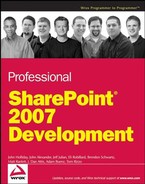 The SharePoint User Experience
by Tom Rizzo, Adam Buenz, J. Dan Attis, Matt Ranlett, Brendon Schwartz, Eli Robilla
Professional SharePoint® 2007 Development
The SharePoint User Experience
by Tom Rizzo, Adam Buenz, J. Dan Attis, Matt Ranlett, Brendon Schwartz, Eli Robilla
Professional SharePoint® 2007 Development
- Copyright
- Dedication
- About the Authors
- Credits
- Acknowledgments
- Foreword
- Introduction
- The Microsoft Application Platform and SharePoint
- MOSS 2007 Overview for Developers
- The SharePoint User Experience
- WSS v3 Platform Services
- Programming Windows SharePoint Services
- A Sample Collaboration Solution
- RSS, Blogs, and Wikis
- Building Personalized Solutions
- Using Enterprise Search
- Using the Business Data Catalog
- Building Document Management Solutions
- Building Records Management Solutions
- Building Web Content Management Solutions
- Electronic Forms in MOSS 2007
- Building Workflow Solutions
- Business Intelligence and SharePoint Server 2007
- Using the Microsoft Visual Studio 2005 Extension for Windows SharePoint Services 3.0
- Installation Requirements
- Building a Custom Solution Using the VSeWSS
- Using VSeWSS to Build Site Definitions and Custom Modules
- Using VSeWSS to Build Content Types
- Building a Custom Content Type Using VSeWSS
- Using VSeWSS to Build List Definitions
- Using VSeWSS to Build Web Parts
- Leveraging the SharePoint Solution Generator
- Summary
- Index
Chapter 3. The SharePoint User Experience
By Brendon Schwartz
Windows SharePoint Services v3 (WSS) provides tremendous functionality right out of the box. When many developers and end users think about performing custom development, they tend to think about having to write code. Because Windows SharePoint Services is a framework, and Microsoft has already written a user interface layer, you can make many development changes without writing any code. This chapter looks at some of the basic functionality that is provided when you install WSS v3. Keep in mind that you will also have this functionality in Office SharePoint Server 2007 because Office SharePoint Server simply builds more functionality on top of the core functionality provided by WSS v3.
WSSv3 provides enhanced lists and libraries that you can use to create a fully functional site. The improvements made to lists give you more control over the performance of the list. For example, lists now contain easier ways to stay connected with users, such as the new RSS feature, but lists still offer you the ability to notify users with email. Lists are useful, but what really makes them powerful is the ability to add metadata that describes the columns included in a list. I start the discussion by looking at a basic list, created by using Site Columns. After that, I discuss Content Types and how you can use them to create more flexible and useful lists with a lot of distinct data in them.
In previous versions of SharePoint, it was difficult to change the overall appearance of a site and to support variations in the site navigation user interface (UI). Now the 2007 version greatly simplifies these tasks by using master pages and site navigation controls borrowed from ASP.NET 2.0, which is the foundation of SharePoint 2007. A master page can provide a common look and feel for all pages in the site, and changes you make to the master page automatically propagate to all dependent pages. Site navigation controls make it easy to display only the links that are relevant to the user.
Finally, this chapter talks about how SharePoint 2007 takes advantage of many other ASP.NET 2.0 features. For instance, SharePoint sites are now compatible with a broad range of browsers and can even be configured for use from mobile devices. In addition, web developers will be happy to learn that SharePoint no longer contains its own page rendering engine but rather uses the one built into ASP.NET. This means that you can build ASP.NET web pages and blend them into a SharePoint site without a lot of rework. In this chapter you take a look at:
The standard features of Windows SharePoint Services v3, including lists and document libraries
The columns of lists, including the Site Columns and Content Types
Enhancements to the user interface and how to modify the site look and feel
The addition of Mobile Development to Windows SharePoint Services v3
-
No Comment